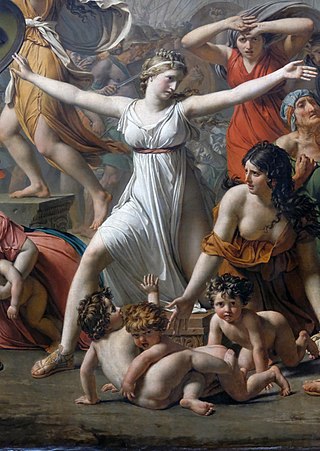
In Greek mythology, Alcmene or Alcmena was the wife of Amphitryon, by whom she bore two children, Iphicles and Laonome. She is best known as the mother of Heracles, whose father was the god Zeus. Alcmene was also referred to as Electryone, a patronymic name as a daughter of Electryon.

Jupiter, also known as Jove, is the god of the sky and thunder, and king of the gods in ancient Roman religion and mythology. Jupiter was the chief deity of Roman state religion throughout the Republican and Imperial eras, until Christianity became the dominant religion of the Empire. In Roman mythology, he negotiates with Numa Pompilius, the second king of Rome, to establish principles of Roman religion such as offering, or sacrifice.

Vesta is the virgin goddess of the hearth, home, and family in Roman religion. She was rarely depicted in human form, and was more often represented by the fire of her temple in the Forum Romanum. Entry to her temple was permitted only to her priestesses, the Vestal Virgins, who guarded particular sacred objects within, prepared flour and sacred salt for official sacrifices, and tended Vesta's sacred fire at the temple hearth. Their virginity was thought essential to Rome's survival; if found guilty of inchastity, they were buried or entombed alive. As Vesta was considered a guardian of the Roman people, her festival, the Vestalia, was regarded as one of the most important Roman holidays. During the Vestalia privileged matrons walked barefoot through the city to the temple, where they presented food-offerings. Such was Vesta's importance to Roman religion that following the rise of Christianity, hers was one of the last non-Christian cults still active, until it was forcibly disbanded by the Christian emperor Theodosius I in AD 391.

In ancient Roman religion, Ceres was a goddess of agriculture, grain crops, fertility and motherly relationships. She was originally the central deity in Rome's so-called plebeian or Aventine Triad, then was paired with her daughter Proserpina in what Romans described as "the Greek rites of Ceres". Her seven-day April festival of Cerealia included the popular Ludi Ceriales. She was also honoured in the May lustration (lustratio) of the fields at the Ambarvalia festival: at harvest-time: and during Roman marriages and funeral rites. She is usually depicted as a mature woman.

In Roman mythology, Hersilia was a figure in the foundation myth of Rome. She is credited with ending the war between Rome and the Sabines.
In ancient Roman religion, Lucina was a title or epithet given to the goddess Juno, and sometimes to Diana, in their roles as goddesses of childbirth who safeguarded the lives of women in labor.

In Roman mythology and religion, Quirinus is an early god of the Roman state. In Augustan Rome, Quirinus was also an epithet of Janus, as Janus Quirinus.

The Sabines were an Italic people who lived in the central Apennine Mountains of the ancient Italian Peninsula, also inhabiting Latium north of the Anio before the founding of Rome.

Festivals in ancient Rome were a very important part in Roman religious life during both the Republican and Imperial eras, and one of the primary features of the Roman calendar. Feriae were either public (publicae) or private (privatae). State holidays were celebrated by the Roman people and received public funding. Games (ludi), such as the Ludi Apollinares, were not technically feriae, but the days on which they were celebrated were dies festi, holidays in the modern sense of days off work. Although feriae were paid for by the state, ludi were often funded by wealthy individuals. Feriae privatae were holidays celebrated in honor of private individuals or by families. This article deals only with public holidays, including rites celebrated by the state priests of Rome at temples, as well as celebrations by neighborhoods, families, and friends held simultaneously throughout Rome.

The Floralia was a festival in ancient Roman religious practice in honor of the goddess Flora, held on 27 April during the Republican era, or 28 April in the Julian calendar. The festival included Ludi Florae, the "Games of Flora", which lasted for six days under the empire.

Juno was an ancient Roman goddess, the protector and special counsellor of the state. She was equated to Hera, queen of the gods in Greek mythology and a goddess of love and marriage. A daughter of Saturn, she was the sister and wife of Jupiter and the mother of Mars, Vulcan, Bellona and Juventas. Like Hera, her sacred animal was the peacock. Her Etruscan counterpart was Uni, and she was said to also watch over the women of Rome. As the patron goddess of Rome and the Roman Empire, Juno was called Regina ("Queen") and was a member of the Capitoline Triad, centered on the Capitoline Hill in Rome, and also including Jupiter, and Minerva, goddess of wisdom.
The Consualia or Consuales Ludi was the name of two ancient Roman festivals in honor of Consus, a tutelary deity of the harvest and stored grain. Consuales Ludi harvest festivals were held on August 21, and again on December 15, in connection with grain storage. The shrine of Consus was underground, it was covered with earth all year and was only uncovered for this one day. Mars, the god of war, as a protector of the harvest, was also honored on this day, as were the Lares, the household gods that individual families held sacred.

The Rape of the Sabine Women, also known as the Abduction of the Sabine Women or the Kidnapping of the Sabine Women, was an incident in Roman mythology in which the men of Rome committed a mass abduction of young women from the other cities in the region. It has been a frequent subject of painters and sculptors, particularly during the Renaissance and post-Renaissance eras.

Ianuarius, fully Mensis Ianuarius, was the first month of the ancient Roman calendar, from which the Julian and Gregorian month of January derived. It was followed by Februarius ("February"). In the calendars of the Roman Republic, Ianuarius had 29 days. Two days were added when the calendar was reformed under Julius Caesar in 45 BCE.

Romulus was the legendary founder and first king of Rome. Various traditions attribute the establishment of many of Rome's oldest legal, political, religious, and social institutions to Romulus and his contemporaries. Although many of these traditions incorporate elements of folklore, and it is not clear to what extent a historical figure underlies the mythical Romulus, the events and institutions ascribed to him were central to the myths surrounding Rome's origins and cultural traditions.

Vulcan is the god of fire including the fire of volcanoes, deserts, metalworking and the forge in ancient Roman religion and myth. He is often depicted with a blacksmith's hammer. The Vulcanalia was the annual festival held August 23 in his honor. His Greek counterpart is Hephaestus, the god of fire and smithery. In Etruscan religion, he is identified with Sethlans.

In ancient Roman religion and myth, Mars was the god of war and also an agricultural guardian, a combination characteristic of early Rome. He was the son of Jupiter and Juno, and was pre-eminent among the Roman army's military gods. Most of his festivals were held in March, the month named for him, and in October, the months which traditionally began and ended the season for both military campaigning and farming.

In ancient Roman religion, the Flamen Quirinalis was the flamen or high priest of the god Quirinus. He was one of the three flamines maiores, third in order of importance after the Flamen Dialis and the Flamen Martialis. Like the other two high priests, he was subject to numerous ritual taboos, such as not being allowed to touch metal, ride a horse, or spend the night outside Rome. His wife functioned as an assistant priestess with the title Flaminicia Quirinalis.















